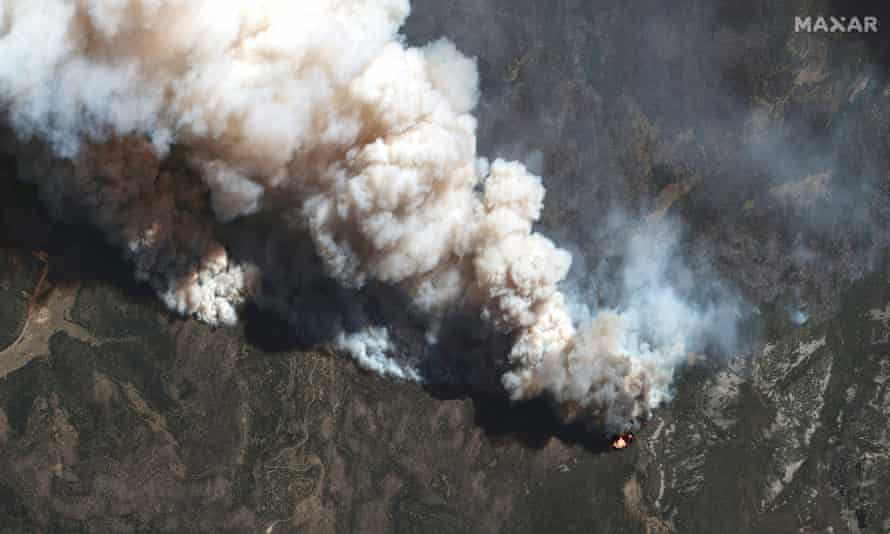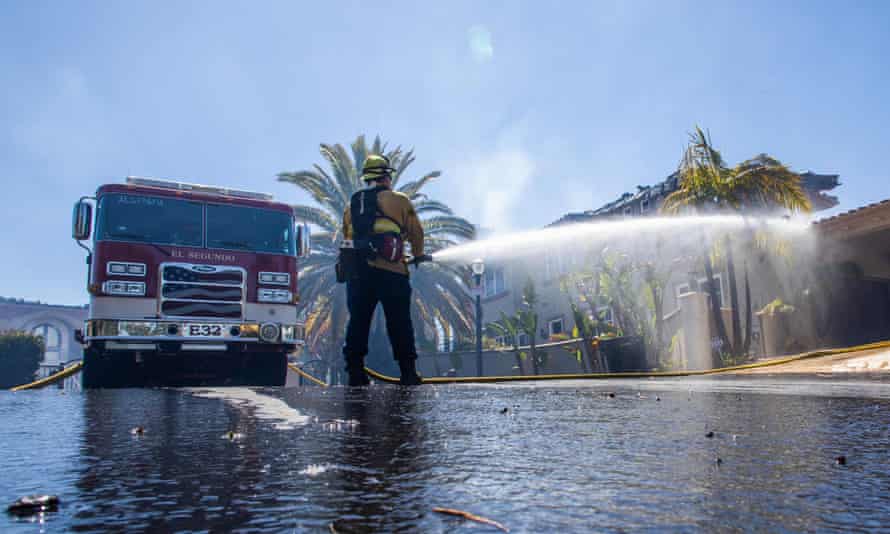The main purpose of this ongoing blog will be to track planetary extreme, or record temperatures related to climate change. Any reports I see of ETs will be listed below the main topic of the day. I’ll refer to extreme or record temperatures as ETs (not extraterrestrials).😉
Main Topic: The Furious Pace of Climate Crisis Heat and Drought Induced Wildfires Across the U.S. in 2022
Dear Diary. My worst fears about this warm season for my country have already been realized. Due to climate change combining with a dry La Niña pattern, a large and historic drought across the West has not diminished. Now a wickedly hot weather pattern or heatwave will occur this week across the South, including areas of the Southwest that have already seen a plethora of conflagrations. Yes, fire season is now 365 days a year thanks to everyone’s carbon emissions.
This is all part of a vicious cycle…High levels of atmospheric CO2 lead to record warmth, which can exacerbate drought, which leads to more record warmth, which start more and more wildfires.
Today as our main topic, let’s pause and take a snapshot of where we are, wildfire wise, across the U.S. before our heatwave that I’ll probably dub Apothos kicks into high gear. To do this here is a Guardian article:
Everything was orange’: US wildfires burning at furious pace early this year
Wind-driven flames tearing through dry vegetation exacerbated by the climate crisis in California and New Mexico
Gabrielle Canon and agencies @GabrielleCanon
Fri 13 May 2022
Extreme conditions have fueled an explosive start to what’s expected to be yet another intense season of big blazes, with months to go before wildfire threats typically peak across the west.
Wildfires have charred close to 1.3m acres nationwide this year, according to the National Interagency Fire Center (NIFC), outpacing the 10-year average for this time of year by more than 71%. Predictions for the rest of the spring do not bode well for the west, with the drought and warmer weather brought on by the climate crisis worsening wildfire danger.
“We all know it’s really early for our fire season and we’re all in awe of what we’ve already experienced,” said Dave Bales, commander on a New Mexico fire that is the largest burning in the US.
From a California hilltop where mansions with multimillion-dollar Pacific Ocean views were torched to remote New Mexico mountains burned by a month-old monster blaze, similar conditions set the stage for the fires, which fire crews are still fighting to contain. Exacerbated by the climate crisis, rising temperatures spurred dryness, turning parched vegetation into fuel. Gusty winds have complicated firefights, carrying embers and fanning the flames through the drought-stricken region.
As the unstoppable northern New Mexico wildfire chewed through more dense forest on Thursday, firefighters in the coastal community of Laguna Niguel doused charred and smoldering remains of 20 large homes that quickly went up in flames and forced a frantic evacuation.
“The sky, everything was orange. It looked like an inferno, so we just jumped in the car,” Sassan Darian said, as he recounted fleeing with his daughter and father while embers swirled around them. “My daughter said, ‘We’re on fire.’ There were sparks on her and we were patting ourselves down.”

Fire officials said there was not much they could do in recent days to stop the fast-moving flames burning in tinder-dry forests in the Sangre de Christo range. Fueled by overgrown mountainsides covered with ponderosa pine and other trees sucked dry of moisture over decades, the fire had burned across more than 270,440 acres – an area bigger than the city of Dallas, Texas – by Friday morning and was 30% contained.
Crews fighting flames along the mountain fronts between Santa Fe and Taos mostly held their own on Thursday thanks to welcome help from aerial attacks. But fire operations chief Todd Abel said that in some places where winds were gusting over ridgetops, it was “almost like putting a hair dryer on it”.
Even small fires that once would have been easily contained are extreme threats to life and property because of climate breakdown, said Brian Fennessy, chief of the Orange county fire authority.
The fire that broke out in southern California on Wednesday afternoon, which may have been sparked by electric utility equipment, was pushed up a canyon by strong sea breezes and quickly ignited large homes. It burned a relatively small area, about 200 acres (81 hectares), and was at 15% containment on Friday but had left a path of destruction.
The weather wasn’t unusual that day in Orange county, with mild temperatures, offshore breezes and high humidity. But the ignition on a steep slope covered in dried vegetation enabled the disaster to develop quickly.
“What we’re seeing that we haven’t seen in years past is these fires are starting and the vegetation is so dry that with any wind behind it — even a normal wind for that area — it’s going to spread faster than we’re used to and faster than we can get our units at the scene,” Fennessy told the Los Angeles Times.
Many of the homes claimed by the flames were built before fire-protective building codes, making them more vulnerable to embers.
A sprawling estate selling for $9.9m had looked in real estate listings like a California dream: teeming with luxuries that included a two-level library, a “wellness wing” with sauna and steam room and a pool on a terrace overlooking scenic Laguna Beach. By nightfall, the mansion once photographed against a pastel sunset had morphed into a nightmare: its arched facade silhouetted against a glowing yellow sky as firefighters trained their hoses on the engulfed structure.

After the big flames died down on Thursday, the house was one of many smoking casualties marked off with yellow tape. In another driveway, a burned-out car rested on its rims. The steep surrounding hillsides were blackened and stripped of vegetation.
Many other homes appeared unscathed and palm trees that had survived the onslaught of embers swayed above in calmer winds. Two firefighters were hospitalized but no other injuries were reported.
The fire’s cause is under investigation and damage inspections were still ongoing on Thursday, TJ McGovern, assistant chief of Orange county fire authority, said.
Southern California Edison reported that unspecified electrical “circuit activity” occurred around the time the fire broke out late Wednesday afternoon.
Electric utility equipment has repeatedly been linked to starting some of the most disastrous California wildfires, especially during windy weather.
The state Public Utilities Commission last year approved a settlement of more than half a billion dollars in fines and penalties for SoCal Edison for its role in five wildfires in 2017 and 2018.
In New Mexico, another red-flag warning was expected to end by Friday night for the first time in a week but extremely low humidity and bone-dry fuels will continue to provide ample opportunity for flames to spread, officials said.
“This fire is going to continue to grow,” Bales, the incident commander, warned on Thursday night.
The blaze has burned more than 170 homes so far, but authorities have said that number is expected to increase significantly as more assessments are done and residents are allowed to return home to areas deemed safe.
The coming months are not likely to offer a reprieve from conditions that favor fires, and several western states are bracing for the hot, dry summer and autumn months. The south-west is forecast to have above normal significant fire potential through June, when fires have historically been the worst for the region. Oregon and the Pacific north-west will start to see the risks rise in July, and California, particularly in the northern part of the state, will face increased threats throughout the summer, according to the NIFC’s latest outlook report.
“Build-up of fuels such as dead trees and brush combines with drought to create a tinderbox ready to burn,” the NIFC wrote in an official update on Friday.
The Associated Press contributed reporting
Topics
Related:
Here are “ET’s” recorded from around the planet the last couple of days and some extreme heat outlooks:
Here is some more April 2022 climatology:
Here is more climate and weather news from Monday:
(As usual, this will be a fluid post in which more information gets added during the day as it crosses my radar, crediting all who have put it on-line. Items will be archived on this site for posterity. In most instances click on the pictures of each tweet to see each article. The most noteworthy items will be listed first.)
(If you like these posts and my work please contribute via the PayPal widget, which has recently been added to this site. Thanks in advance for any support.)
Guy Walton “The Climate Guy”